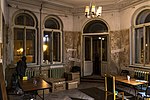Institute of Applied Astronomy
The Institute of Applied Astronomy of the Russian Academy of Sciences (name in Russian: Институт прикладной астрономии — official name in Russian: Федеральное государственное бюджетное учреждение науки Институт прикладной астрономии Российской академии наук (Federal State Budgetary Institution of Science Institute of Applied Astronomy of the Russian Academy of Sciences) — abbreviated name in Russian: ИПА РАН — abbreviated name in English: IAA RAS) is one of the world's largest astronomical institutes, known for research in ephemeris astronomy, classical and relativistic celestial mechanics, radio astronomy and radio interferometry, space geodesy, fundamental coordinate-time support, and development of new methods in astrometry and geodynamics.
Excerpt from the Wikipedia article Institute of Applied Astronomy (License: CC BY-SA 3.0, Authors).Institute of Applied Astronomy
Kutuzov Embankment, Saint Petersburg
Geographical coordinates (GPS) Address Website External links Nearby Places Show on map
Geographical coordinates (GPS)
| Latitude | Longitude |
|---|---|
| N 59.948888888889 ° | E 30.345 ° |
Address
Институт прикладной астрономии
Kutuzov Embankment
191187 Saint Petersburg (Литейный округ)
Saint Petersburg, Russia
Open on Google Maps









